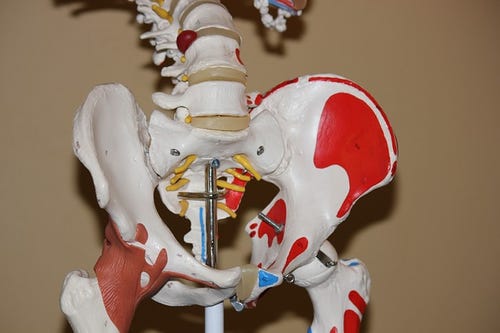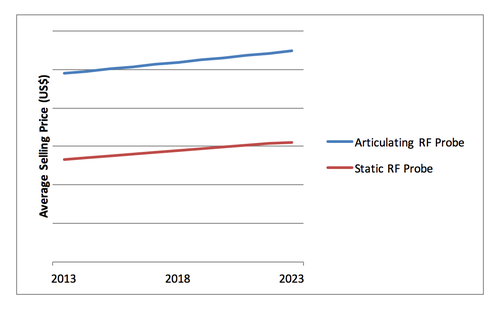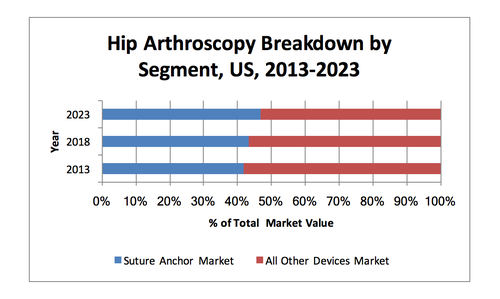U.S. Hip Arthroscopy Market Shaped by Innovation and Increased Interest
June 12, 2017
The U.S. market for hip arthroscopy is undergoing significant growth in response to technological innovation and changes in the competitive landscape.
Matthew Choi and Jeffrey Wong

Hip arthroscopy is a minimally invasive procedure commonly performed to treat femoralacetabular impingement (FAI) and labral tears. The number of people affected by FAI and labral tears is currently unknown due to a lack of proper diagnostic tools and the fact that most conditions remain asymptomatic.1 The U.S. market for hip arthroscopy is undergoing significant growth in response to technological innovation and changes in the competitive landscape. The major segments affected by this growth are radiofrequency probes, hip access kits, suture anchors, and suture passers.
Increasing Demand for Hip Arthroscopy
Surgeons are starting to transition from open hip surgeries to arthroscopic procedures. Overall, the hip arthroscopy market is experiencing growth. Hip arthroscopy gained traction in the 1980s, but advancements in diagnosis and techniques are relatively recent.2 Labral tears and FAI are the most common conditions treated with hip arthroscopy. However, these disorders were hard to diagnose and are usually asymptomatic.1 With the recent advancements in technology, FAI has been easier to diagnose with better clinical examinations, radiological imaging with magnetic resonance arthrography (MRA), and computed tomography (CT) technology.3, 4 With the increase of diagnoses, procedure growth should rise accordingly.
Hip arthroscopy is a complex operation that requires extensive training and is usually only offered in developed nations.5 Surgeons are more likely to be trained in arthroplasty rather than hip arthroscopy across all countries.5 However, North American and European surgeons are more likely to be trained in hip arthroscopy compared with other surgeons in Asia and Africa.5 As more research is conducted for hip arthroscopy, more surgeons are expected to be trained in and prescribe hip arthroscopy, which will likely drive market growth.
Hip arthroscopy is becoming a common treatment due to its low rates of complications and the ability to delay the need for open surgery and osteoarthritis.4, 6, 7 FAI causes osteoarthritis when the bone protrusion damages the hip labrum.3 As the hip labrum is damaged, osteoarthritis will set in and cause hip pain. Hip arthroscopy is becoming more relevant as it has substantially lower rates of complications, around half of open hip surgery.
Currently, hip arthroscopy is limited by its high cost and long operating time. Although hip arthroscopy costs less than open surgery, hip arthroscopy is the highest costing arthroscopic procedure out of all the arthroscopic procedures.8 There should be no changes with the cost per procedure as the average selling price (ASP) of devices required is expected to remain stable, but the operating time can change with product innovation. For example, knotless suture anchors are used mainly for the fact that they decrease surgery time. As more product innovations occur, the operation time for hip arthroscopy should decrease and grow the market.
While FAI and hip labrum repair are the main hip arthroscopic repairs performed, it is expected that more techniques will be explored as hip arthroscopy becomes more common.9 Some of the other pathologies being studied involve anterior-inferior iliac spine syndrome and psoas impingement.9 FAI is a good initial procedure to springboard hip arthroscopy into relevance.
Pricing Pressure in the Radiofrequency Probes
Radiofrequency (RF) probes are a high-cost instrument used in hip arthroscopy. RF probes comprise a large percentage of the hip arthroscopy total market value and have been consistently growing due to their ability to precisely remove soft tissue. RF probes have a high ASP in the hip arthroscopy market that is not expected to experience any significant change. The main growth comes from a moderate to high increase in unit sales per year. RF probes are segmented into articulating and static RF probes, with articulating RF probes historically being the larger segment.

With the recent advancements in hip arthroscopy techniques, surgeons have found that static RF probes are more effective compared with articulating RF probes for hip arthroscopy. Hip arthroscopy requires a more stable instrument due to the large capsulotomy procedures, which makes static RF probes more ideal. In addition, the static RF probes have a substantially lower ASP compared with the articulating RF probes. These two factors have caused shifts in the RF probe market segment, with static RF probes expected to overtake articulating RF probes as the dominant segment in the near future.
Changing Competitive Landscape
The competitive landscape for hip arthroscopy has not experienced any major change as of yet but is expected to change in the near future. Smith & Nephew will see its leading position challenged, as companies like Arthrex and Stryker put more resources into the market. Stryker, in particular, has gained a presence in the hip arthroscopy market with its acquisition of Pivot Medical, which specializes in this market. Additionally, the radiofrequency probe market will be disrupted by the emergence of static radiofrequency probes that is more useful for larger capsulotomy procedures.

Meanwhile, the suture anchor segment has been experiencing product innovation coming from technological advancements. Suture anchors for hip repair are the largest portion of the total hip arthroscopy market. All-suture anchors are a rapidly growing product segment mainly used in shoulder arthroscopy procedures but can also be used for hip labral repairs. If all-suture anchors gain in popularity in hip arthroscopy like they have with shoulder arthroscopy, there will be a major shift in the competitive landscape. Zimmer Biomet has traditionally been the leader of the all-suture anchor market, but the company has little presence in the hip repair market, which could change as all-suture anchors continue to grow.
Overall, technological innovation, changes in the competitive landscape, and continued growth of the procedure will be the main drivers of the U.S. hip arthroscopy market moving forward.
References
Briggs K., Philippon M., Ho C. and McNarnara S., 2017. Prevalence of Acetabular Labral Tears in Asymptomatic Young Athletes. 51: 303. DOI: 10.1136/bjsports-2016-097372.50
Villar R., 2016. Education and Hip Arthroscopy. Hip joint Restoration. 915-917. DOI: 10.1007/978-1-4614-0694-5_98
Banerjee P. and Mclean C., 2011. Femoroacetabular impingement: a review of diagnosis and management. 4(1): 23-32. DOI: 10.1007/s12178-011-9073-z
Bozic K., Chan V., Valone K., Feeley B. and Vail T., 2013. Trends in Hip Arthroscopy Utilization in the United States. 28(8): 140-148. DOI: 10.1016/j.arth.2013.02.039
Khan M., Ayeni O., Madden K., Bedi A., Ranawat A. and Kelly B., 2016. Femoroacetabular Impingement: Have We Hit a Global Tipping Point in Diagnosis and Treatment? Results From the InterNational Femoroacetabular Impingement Optimal Care Update Survey (IN FOCUS). 32(5): 779-787. DOI: 10.1016/j.arthro.2015.10.011
Gupta A., Redmond J., Hammarstedt J., Schwindel L. and Domb B., 2014. Safety Measures in Hip Arthroscopy and Their Efficacy in Minimizing Complications: A Systematic Review of the Evidence. 30(10): 1342-1348. DOI: 10.1016/j.arthro.2014.04.103
Botser I., Smith T., Nasser R. and Domb B., 2011. Open Surgical Dislocation Versus Arthroscopy for Femoroacetabular Impingement: A Comparison of Clinical Outcomes. 27(2): 270-278. DOI: 10.1016/j.arthro.2010.11.008
SA D., Horner N., MacDonald A., Simunnovic N., Slobogean., Philippon M., Belzile E., Karlsson J. and Ayeni O., 2016.Evaluating healthcare resource utilization and outcomes for surgical hip dislocation and hip arthroscopy for femoroacetabular impingement. 24(12): 3943-3954. DOI: 10.1007/s00167-015-3722-5
Ayeni O., Levy B., Musahi V. and Safran M., 2014. Current state-of-the-art of hip arthroscopy. 22: 711-713. DOI: 10.1007/s00167-014-2866-z
Matthew Choi is a research analyst at iData Research and was the lead researcher for the U.S. Orthopedic Soft Tissue Report Suite.
Jeffrey Wong is the strategic analyst manager at iData Research and has been heavily involved with the company's orthopedic division throughout his tenure. As a research analyst, he led several research projects on key global orthopedic device markets, including traditional and minimally invasive spinal implants, motion preservation spine devices, VCF treatment, craniomaxillofacial devices, and bone graft substitutes.
[image courtesy of IAOM-US/PIXABAY.COM]
About the Author(s)
You May Also Like

.png?width=300&auto=webp&quality=80&disable=upscale)
